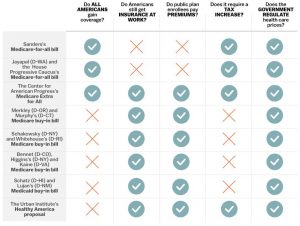The following article by Ruy Teixeira, author of The Optimistic Leftist and other works of political analysis, is cross-posted from his blog:
David Leonhardt makes this argument–correctly in my view–in his column in the New York Times. And check out the chart below for some of the evidence for his argument.
“There is only one quality — beyond, of course, charisma — that Democrats should demand in their nominee. The Democrats need a candidate who can and will run as an economic populist.
They need a candidate who will organize the 2020 campaign around fighting for the little guy and gal. (And most of the potential Democratic nominees could do so.) It would be a campaign about Republican politicians and corporate lobbyists who are rigging the game, a campaign that promised good jobs, rising wages, decent health care, affordable education and an end to Trumpian corruption.
The country doesn’t only need this agenda. It wants this agenda. A mountain of evidence shows that populism — the real kind, not the faux Trump version — is the Democrats’ most effective political strategy. Yet that evidence often gets obscured by less important issues, like a candidate’s race, sex or precise spot on a traditional liberal-conservative spectrum……
Populism takes very different forms — from odious racism to sensible economics — but there is no other political style consistently succeeding in the Western world right now.
There is more than one form that a Democratic populist can take. Franklin Roosevelt, the most successful populist of the past century, was an aristocrat. Bill Clinton and Lyndon Johnson were hardscrabble Southerners. Barack Obama managed to do quite well with much of the white working class despite having one big obvious difference from them.
So the need to run a populist campaign in 2020 doesn’t point to any specific candidate….
[A]lmost every single one of the potential Democratic candidates could run a smart populist campaign. Take Beto O’Rourke. His record in the House was not especially populist. He cast a procedural vote for a trans-Pacific trade deal, for example. Yet his Texas Senate campaign captured the energy of the moment. In campaign ads, his top issues included: “Get big money out of politics” and “Jobs for Texans.”
We’re living in a populist era. The question is who figures out how to thrive in it. In 2016, it was Trump. It doesn’t need to be in 2020.”
Exactly. And I would add that the approach Leonhardt recommends could put into play the basic components of the “equitable growth” agenda this country so desperately needs to move forward and leave reactionary populism behind for good.
As I conceive of it, the equitable growth approach has three broad components: (1) measures to directly improve economic outcomes for the working and middle classes; (2) measures to directly reduce the flow of excessive benefits to the wealthy; and (3) measures to increase societal investment in the jobs of the future.
Measures to directly improve economic outcomes should include the following. First, there is the provision of more and more widely-distributed educational opportunity. This provision is absolutely central to the life-chances and economic mobility of the working and middle classes. Making early childhood education available for all is part of this, as is more effective elementary and secondary education and much easier access to a college education.
Raising the quality and quantity of educational attainment helps individual workers but it does much more. Broad diffusion of knowledge and skills is a powerful countervailing force on rising inequality. And the role of rising societal skill levels in promoting economic growth is well-documented.
Policies to directly support wages are also important. A relatively high minimum wage, indexed to prices, fits in here, as do pro-work tax credits like the Earned Income Tax Credit and employee profit-sharing, share-ownership and representation. And, critically, the attainment and maintenance of full employment, including government as employer of last resort, will do a great deal to push wages up over the long-term.
Then there is the role of robust social insurance and social benefits. Besides the familiar old age programs of Social Security and Medicare, this includes the universal provision of health care, affordable child care, retirement savings accounts, paid sick and parental leave and paid vacation.
There is no question these measures would go a long way toward improving the lot of the working and middle classes in today’s America. But an equitable growth approach entails going beyond directly helping the great middle to cutting the flow of excessive benefits to the wealthy.
One part of this is increasing taxes on the wealthy and on wealth. As Thomas Piketty argues, low marginal income tax rates on the wealthy encourage the pursuit of extreme incomes, while much higher marginal rates can be implemented without adverse effects on work effort and entrepreneurship.
Curtailing wealth through tax increases on the wealthy would, by definition, make a contribution toward reducing inequality by pushing down excess at the top of the income distribution. These measures would also have the highly desirable side effect of helping raise revenue for needed social programs and government investments to lift up the great middle of society (even if such taxes, by themselves, would not be sufficient to provide all the revenue needed).
There is also the issue of laws and incentives that encourage excessive and destabilizing wealth accumulation. A host of changes are needed here. Measures to combat these tendencies include ending “too big to fail” in the financial sector, enacting a financial transactions tax to discourage short-term, speculative investments and eliminating tax loopholes on performance pay and other forms of compensation that have allowed CEO pay to skyrocket.
Direct measures to lift up the middle and push down the top are clearly necessary and important parts of an equitable growth program. But they are not sufficient. Sustained healthy economic growth also depends on increased long-term societal investment in the infrastructure, research and sectoral innovation that will underpin the jobs of the future.
There are obviously a lot of moving parts here. But several things are clear. There has been a systematic tendency to underinvest in infrastructure, both its maintenance and expansion to suit the needs of modern postindustrial economies. This tendency has been particularly acute in the United States, where investment in infrastructure is now at historical lows, despite an immense backlog of deferred maintenance and mostly unfilled needs for new infrastructure.
This underinvestment reflects in large part unwarranted faith in the ability of the private sector to “go it alone” and drive growth purely on the basis of entrepreneurship and profit-seeking. This ignores, of course, the well-known economic problem of “public goods” that are useful and necessary for many economic actors but are available to all regardless of whether they have contributed anything to the availability of the public good (“free-riding”) and cannot be appropriated for the exclusive use of any profit-making firm. Infrastructure is a classic example of such a public good, as is some basic research.
In the absence of a robust supply of public goods, some firms will still make healthy profits and economic growth will still continue. But growth will be less than it otherwise would be and it will be tilted toward areas where large profits do not depend on public goods (think finance). Good for those firms that do make large profits, bad for the working and middle classes.
Worse, the problem goes beyond that indicated by the public goods framework. As economist Mariana Mazzucato points out, the role of the state is not just to supply public goods the private sector ignores but needs (though this is very important) but also to be an entrepreneurial agent investing in areas that are far off the private sector’s radar screen because of extreme uncertainty in economic returns. This is particularly the case with fundamental knowledge generation and very early investments in new technological sectors. Current theories of economic growth assign such innovation a key role in economic growth and it is the “entrepreneurial state” in Mazzucato’s phrase who can afford—and is willing–to bear the inherently immeasurable risks of such innovation.
This has been the case in the United States where pretty much all research underlying the internet and modern computing was funded and initially capitalized by the US state. For example, the immensely profitable Apple corporation’s signature products, like the iPhone and iPad, rest on fundamental innovations developed by government funding . This includes everything from the internet to GPS to touch screens to Siri voice recognition. In other words, no entrepreneurial state, no Apple.
More generally, a Brookings Institution study found that 18 of the 25 most important breakthroughs in computer technology in the seminal 1946-65 period were underwritten by the federal government . And it’s not just information technology where the role of the state has been critical: between 1971 and 2006, 77 out of the 88 most important innovations outside of computing/communications, as rated by R&D Magazine, were heavily dependent on government support, especially in their earliest developmental stages.
The role of the entrepreneurial state has been critical to growth in the past and there is no reason to think it will not be critical in the future. Progress in such emerging fields as biotechnology, nanotechnology and, of paramount importance, green technology will continue to depend on the entrepreneurial state being willing to provide support in areas where the private sector sees only unknowable risks. And without such progress economic growth–and the consequent ability to raise living standards–will fall well short of potential.
It’s a big program and getting rid of Trump is just the first step. But it’s what we need.





